Managing Across Cultures: Analysis of Hofstede's Model
VerifiedAdded on 2022/11/07
|9
|2036
|90
AI Summary
This essay analyses Hofstede's cultural dimension model and its implementation by managers to develop multicultural organizations. It also discusses the impact of values on culture and the cross-cultural management activities performed by organizations.
Contribute Materials
Your contribution can guide someone’s learning journey. Share your
documents today.
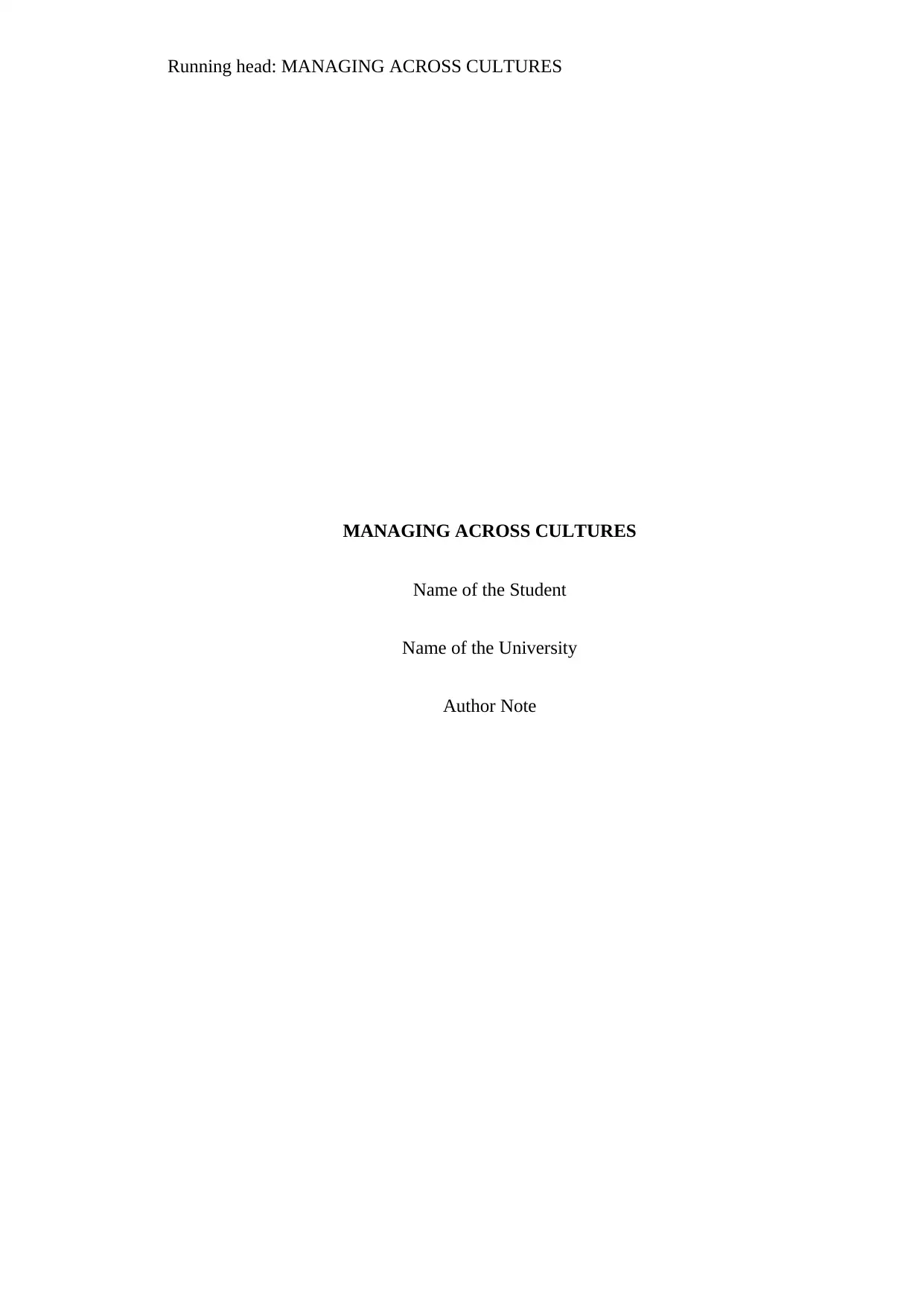
Running head: MANAGING ACROSS CULTURES
MANAGING ACROSS CULTURES
Name of the Student
Name of the University
Author Note
MANAGING ACROSS CULTURES
Name of the Student
Name of the University
Author Note
Secure Best Marks with AI Grader
Need help grading? Try our AI Grader for instant feedback on your assignments.
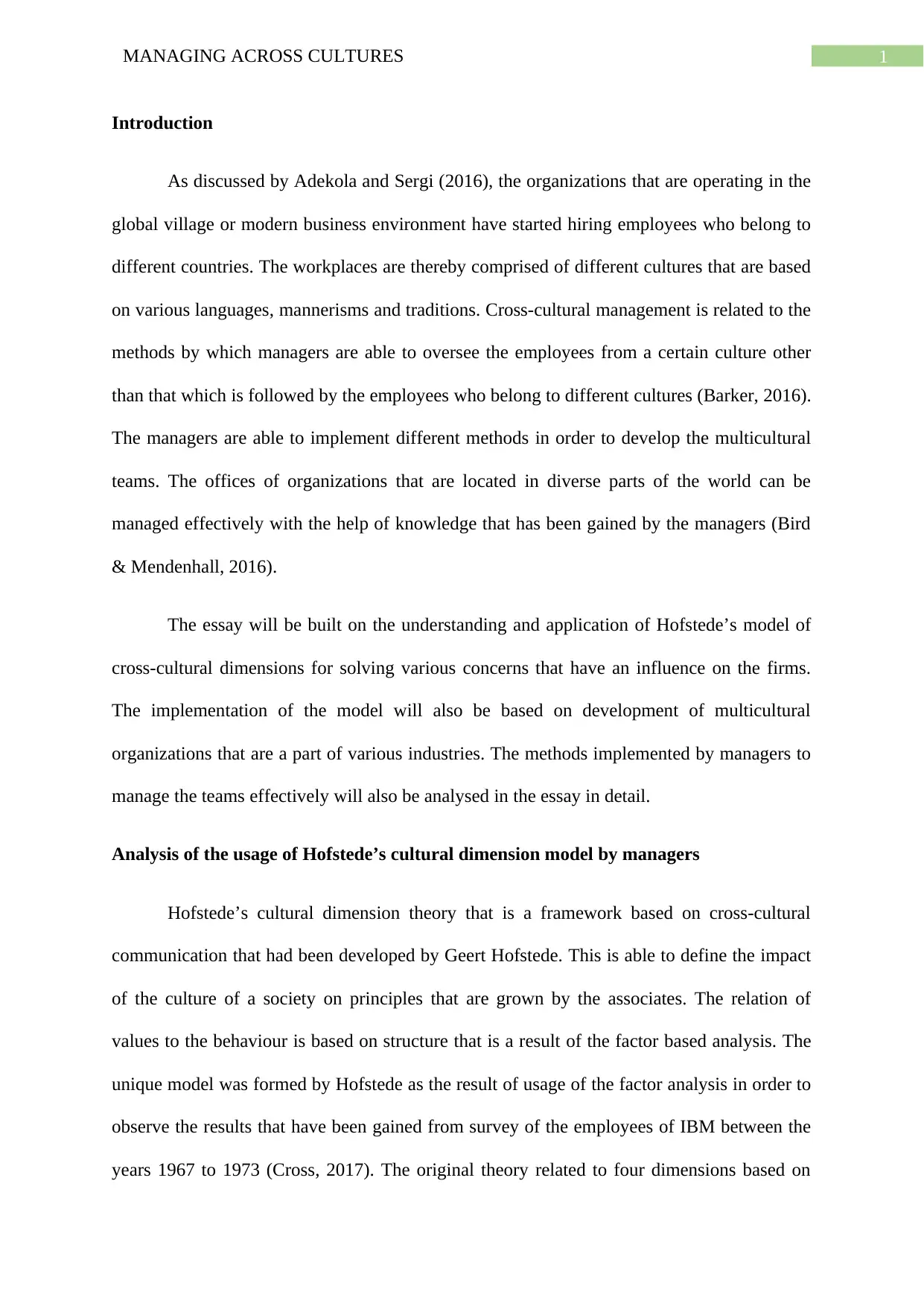
1MANAGING ACROSS CULTURES
Introduction
As discussed by Adekola and Sergi (2016), the organizations that are operating in the
global village or modern business environment have started hiring employees who belong to
different countries. The workplaces are thereby comprised of different cultures that are based
on various languages, mannerisms and traditions. Cross-cultural management is related to the
methods by which managers are able to oversee the employees from a certain culture other
than that which is followed by the employees who belong to different cultures (Barker, 2016).
The managers are able to implement different methods in order to develop the multicultural
teams. The offices of organizations that are located in diverse parts of the world can be
managed effectively with the help of knowledge that has been gained by the managers (Bird
& Mendenhall, 2016).
The essay will be built on the understanding and application of Hofstede’s model of
cross-cultural dimensions for solving various concerns that have an influence on the firms.
The implementation of the model will also be based on development of multicultural
organizations that are a part of various industries. The methods implemented by managers to
manage the teams effectively will also be analysed in the essay in detail.
Analysis of the usage of Hofstede’s cultural dimension model by managers
Hofstede’s cultural dimension theory that is a framework based on cross-cultural
communication that had been developed by Geert Hofstede. This is able to define the impact
of the culture of a society on principles that are grown by the associates. The relation of
values to the behaviour is based on structure that is a result of the factor based analysis. The
unique model was formed by Hofstede as the result of usage of the factor analysis in order to
observe the results that have been gained from survey of the employees of IBM between the
years 1967 to 1973 (Cross, 2017). The original theory related to four dimensions based on
Introduction
As discussed by Adekola and Sergi (2016), the organizations that are operating in the
global village or modern business environment have started hiring employees who belong to
different countries. The workplaces are thereby comprised of different cultures that are based
on various languages, mannerisms and traditions. Cross-cultural management is related to the
methods by which managers are able to oversee the employees from a certain culture other
than that which is followed by the employees who belong to different cultures (Barker, 2016).
The managers are able to implement different methods in order to develop the multicultural
teams. The offices of organizations that are located in diverse parts of the world can be
managed effectively with the help of knowledge that has been gained by the managers (Bird
& Mendenhall, 2016).
The essay will be built on the understanding and application of Hofstede’s model of
cross-cultural dimensions for solving various concerns that have an influence on the firms.
The implementation of the model will also be based on development of multicultural
organizations that are a part of various industries. The methods implemented by managers to
manage the teams effectively will also be analysed in the essay in detail.
Analysis of the usage of Hofstede’s cultural dimension model by managers
Hofstede’s cultural dimension theory that is a framework based on cross-cultural
communication that had been developed by Geert Hofstede. This is able to define the impact
of the culture of a society on principles that are grown by the associates. The relation of
values to the behaviour is based on structure that is a result of the factor based analysis. The
unique model was formed by Hofstede as the result of usage of the factor analysis in order to
observe the results that have been gained from survey of the employees of IBM between the
years 1967 to 1973 (Cross, 2017). The original theory related to four dimensions based on
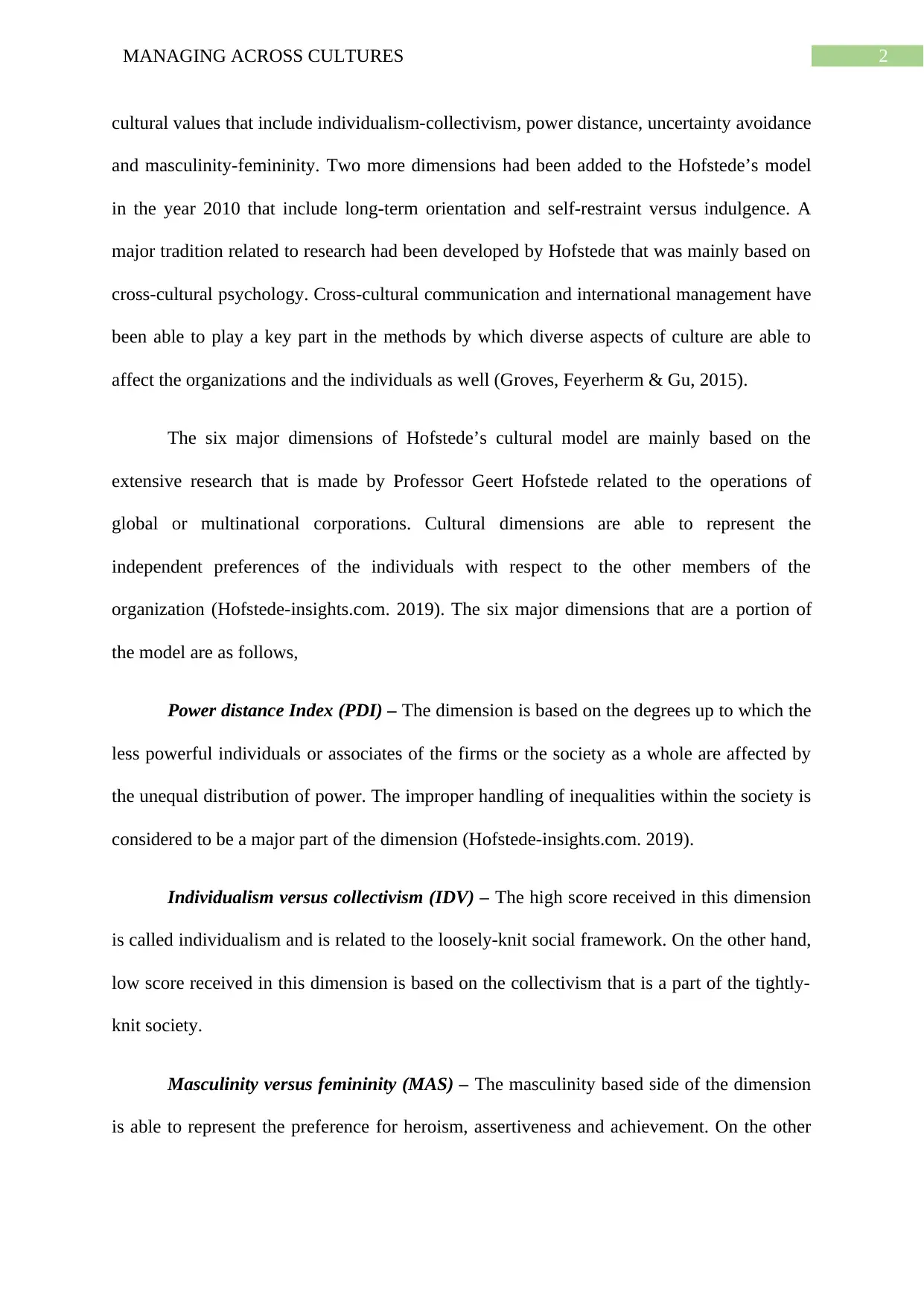
2MANAGING ACROSS CULTURES
cultural values that include individualism-collectivism, power distance, uncertainty avoidance
and masculinity-femininity. Two more dimensions had been added to the Hofstede’s model
in the year 2010 that include long-term orientation and self-restraint versus indulgence. A
major tradition related to research had been developed by Hofstede that was mainly based on
cross-cultural psychology. Cross-cultural communication and international management have
been able to play a key part in the methods by which diverse aspects of culture are able to
affect the organizations and the individuals as well (Groves, Feyerherm & Gu, 2015).
The six major dimensions of Hofstede’s cultural model are mainly based on the
extensive research that is made by Professor Geert Hofstede related to the operations of
global or multinational corporations. Cultural dimensions are able to represent the
independent preferences of the individuals with respect to the other members of the
organization (Hofstede-insights.com. 2019). The six major dimensions that are a portion of
the model are as follows,
Power distance Index (PDI) – The dimension is based on the degrees up to which the
less powerful individuals or associates of the firms or the society as a whole are affected by
the unequal distribution of power. The improper handling of inequalities within the society is
considered to be a major part of the dimension (Hofstede-insights.com. 2019).
Individualism versus collectivism (IDV) – The high score received in this dimension
is called individualism and is related to the loosely-knit social framework. On the other hand,
low score received in this dimension is based on the collectivism that is a part of the tightly-
knit society.
Masculinity versus femininity (MAS) – The masculinity based side of the dimension
is able to represent the preference for heroism, assertiveness and achievement. On the other
cultural values that include individualism-collectivism, power distance, uncertainty avoidance
and masculinity-femininity. Two more dimensions had been added to the Hofstede’s model
in the year 2010 that include long-term orientation and self-restraint versus indulgence. A
major tradition related to research had been developed by Hofstede that was mainly based on
cross-cultural psychology. Cross-cultural communication and international management have
been able to play a key part in the methods by which diverse aspects of culture are able to
affect the organizations and the individuals as well (Groves, Feyerherm & Gu, 2015).
The six major dimensions of Hofstede’s cultural model are mainly based on the
extensive research that is made by Professor Geert Hofstede related to the operations of
global or multinational corporations. Cultural dimensions are able to represent the
independent preferences of the individuals with respect to the other members of the
organization (Hofstede-insights.com. 2019). The six major dimensions that are a portion of
the model are as follows,
Power distance Index (PDI) – The dimension is based on the degrees up to which the
less powerful individuals or associates of the firms or the society as a whole are affected by
the unequal distribution of power. The improper handling of inequalities within the society is
considered to be a major part of the dimension (Hofstede-insights.com. 2019).
Individualism versus collectivism (IDV) – The high score received in this dimension
is called individualism and is related to the loosely-knit social framework. On the other hand,
low score received in this dimension is based on the collectivism that is a part of the tightly-
knit society.
Masculinity versus femininity (MAS) – The masculinity based side of the dimension
is able to represent the preference for heroism, assertiveness and achievement. On the other
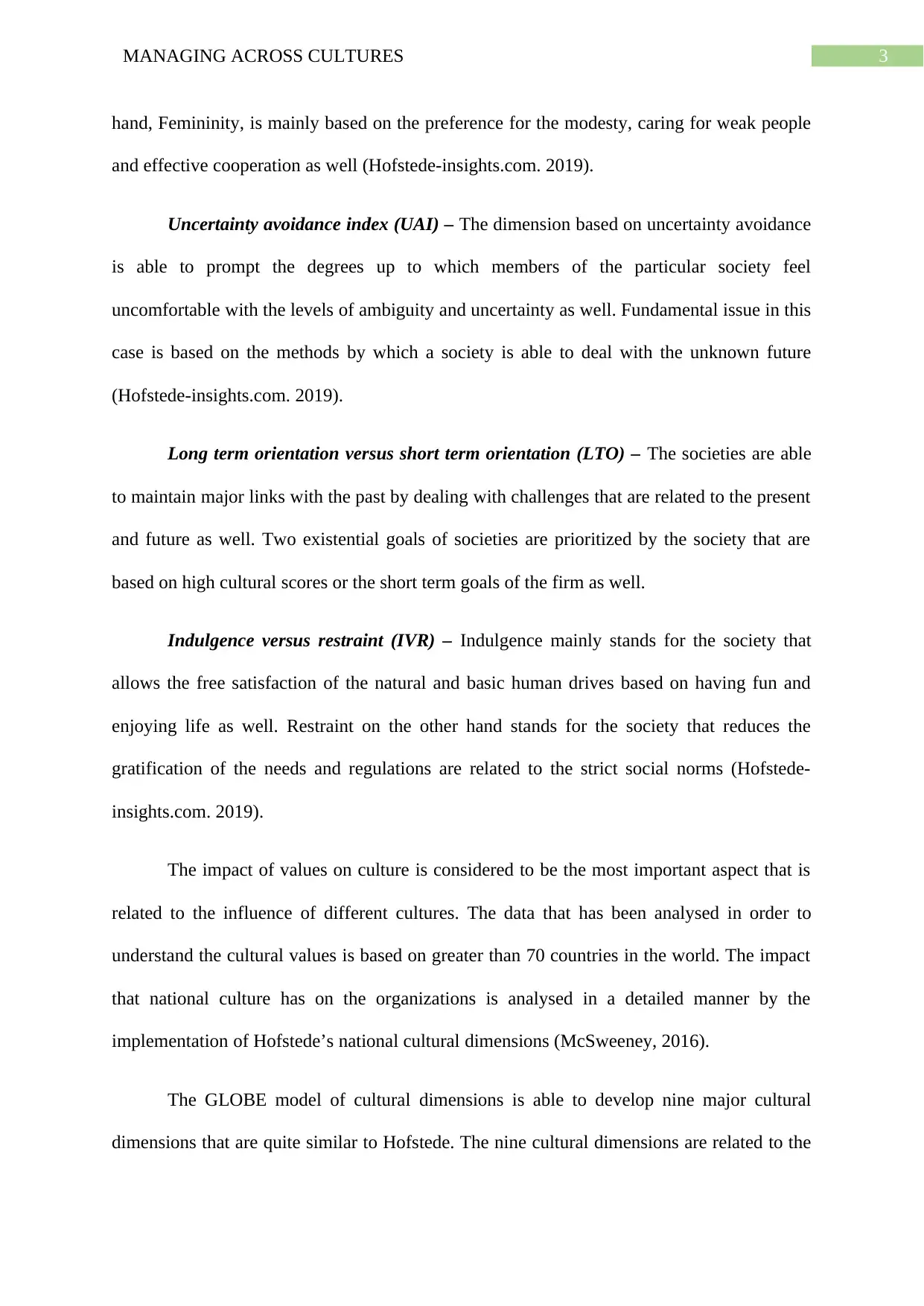
3MANAGING ACROSS CULTURES
hand, Femininity, is mainly based on the preference for the modesty, caring for weak people
and effective cooperation as well (Hofstede-insights.com. 2019).
Uncertainty avoidance index (UAI) – The dimension based on uncertainty avoidance
is able to prompt the degrees up to which members of the particular society feel
uncomfortable with the levels of ambiguity and uncertainty as well. Fundamental issue in this
case is based on the methods by which a society is able to deal with the unknown future
(Hofstede-insights.com. 2019).
Long term orientation versus short term orientation (LTO) – The societies are able
to maintain major links with the past by dealing with challenges that are related to the present
and future as well. Two existential goals of societies are prioritized by the society that are
based on high cultural scores or the short term goals of the firm as well.
Indulgence versus restraint (IVR) – Indulgence mainly stands for the society that
allows the free satisfaction of the natural and basic human drives based on having fun and
enjoying life as well. Restraint on the other hand stands for the society that reduces the
gratification of the needs and regulations are related to the strict social norms (Hofstede-
insights.com. 2019).
The impact of values on culture is considered to be the most important aspect that is
related to the influence of different cultures. The data that has been analysed in order to
understand the cultural values is based on greater than 70 countries in the world. The impact
that national culture has on the organizations is analysed in a detailed manner by the
implementation of Hofstede’s national cultural dimensions (McSweeney, 2016).
The GLOBE model of cultural dimensions is able to develop nine major cultural
dimensions that are quite similar to Hofstede. The nine cultural dimensions are related to the
hand, Femininity, is mainly based on the preference for the modesty, caring for weak people
and effective cooperation as well (Hofstede-insights.com. 2019).
Uncertainty avoidance index (UAI) – The dimension based on uncertainty avoidance
is able to prompt the degrees up to which members of the particular society feel
uncomfortable with the levels of ambiguity and uncertainty as well. Fundamental issue in this
case is based on the methods by which a society is able to deal with the unknown future
(Hofstede-insights.com. 2019).
Long term orientation versus short term orientation (LTO) – The societies are able
to maintain major links with the past by dealing with challenges that are related to the present
and future as well. Two existential goals of societies are prioritized by the society that are
based on high cultural scores or the short term goals of the firm as well.
Indulgence versus restraint (IVR) – Indulgence mainly stands for the society that
allows the free satisfaction of the natural and basic human drives based on having fun and
enjoying life as well. Restraint on the other hand stands for the society that reduces the
gratification of the needs and regulations are related to the strict social norms (Hofstede-
insights.com. 2019).
The impact of values on culture is considered to be the most important aspect that is
related to the influence of different cultures. The data that has been analysed in order to
understand the cultural values is based on greater than 70 countries in the world. The impact
that national culture has on the organizations is analysed in a detailed manner by the
implementation of Hofstede’s national cultural dimensions (McSweeney, 2016).
The GLOBE model of cultural dimensions is able to develop nine major cultural
dimensions that are quite similar to Hofstede. The nine cultural dimensions are related to the
Secure Best Marks with AI Grader
Need help grading? Try our AI Grader for instant feedback on your assignments.
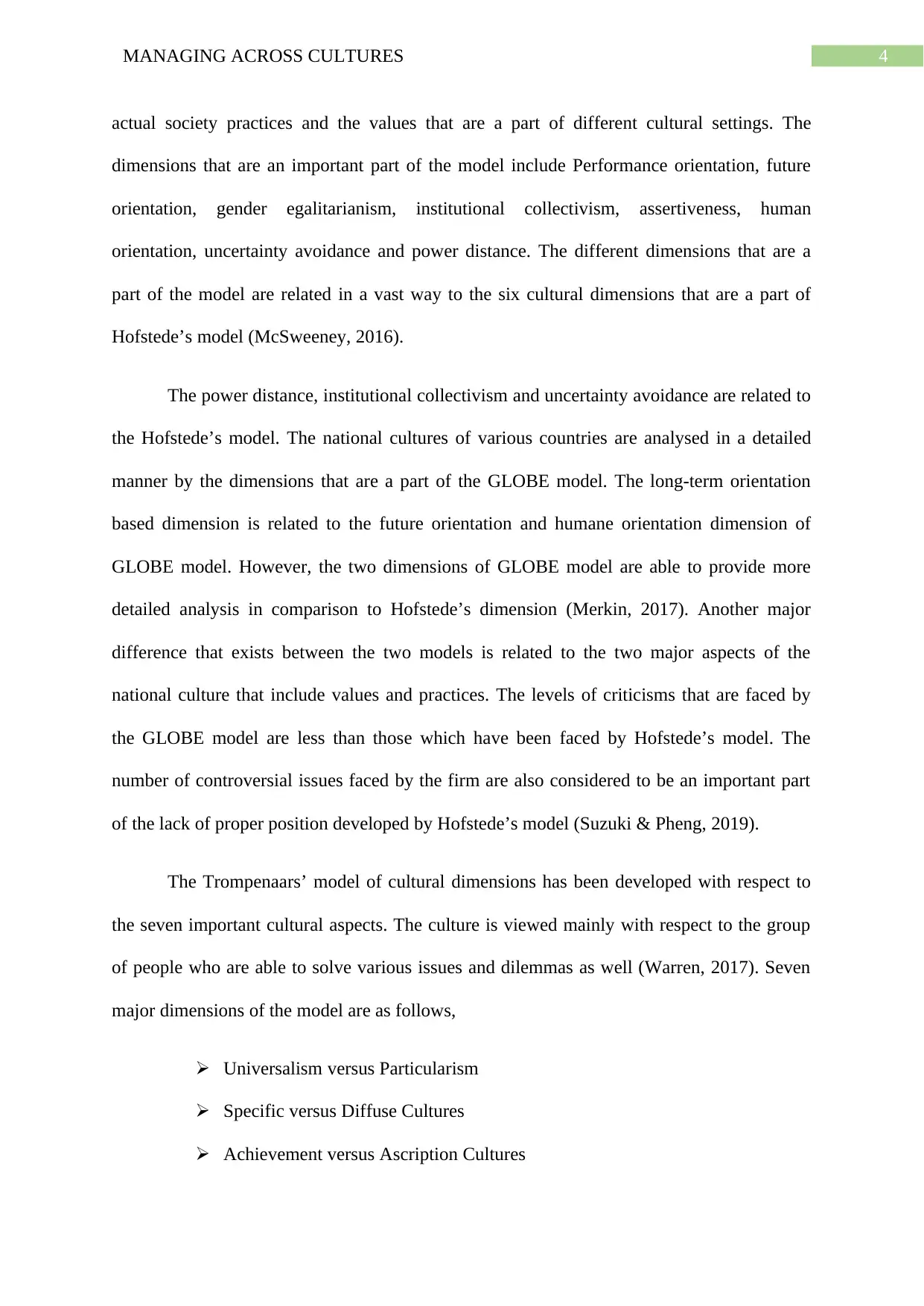
4MANAGING ACROSS CULTURES
actual society practices and the values that are a part of different cultural settings. The
dimensions that are an important part of the model include Performance orientation, future
orientation, gender egalitarianism, institutional collectivism, assertiveness, human
orientation, uncertainty avoidance and power distance. The different dimensions that are a
part of the model are related in a vast way to the six cultural dimensions that are a part of
Hofstede’s model (McSweeney, 2016).
The power distance, institutional collectivism and uncertainty avoidance are related to
the Hofstede’s model. The national cultures of various countries are analysed in a detailed
manner by the dimensions that are a part of the GLOBE model. The long-term orientation
based dimension is related to the future orientation and humane orientation dimension of
GLOBE model. However, the two dimensions of GLOBE model are able to provide more
detailed analysis in comparison to Hofstede’s dimension (Merkin, 2017). Another major
difference that exists between the two models is related to the two major aspects of the
national culture that include values and practices. The levels of criticisms that are faced by
the GLOBE model are less than those which have been faced by Hofstede’s model. The
number of controversial issues faced by the firm are also considered to be an important part
of the lack of proper position developed by Hofstede’s model (Suzuki & Pheng, 2019).
The Trompenaars’ model of cultural dimensions has been developed with respect to
the seven important cultural aspects. The culture is viewed mainly with respect to the group
of people who are able to solve various issues and dilemmas as well (Warren, 2017). Seven
major dimensions of the model are as follows,
Universalism versus Particularism
Specific versus Diffuse Cultures
Achievement versus Ascription Cultures
actual society practices and the values that are a part of different cultural settings. The
dimensions that are an important part of the model include Performance orientation, future
orientation, gender egalitarianism, institutional collectivism, assertiveness, human
orientation, uncertainty avoidance and power distance. The different dimensions that are a
part of the model are related in a vast way to the six cultural dimensions that are a part of
Hofstede’s model (McSweeney, 2016).
The power distance, institutional collectivism and uncertainty avoidance are related to
the Hofstede’s model. The national cultures of various countries are analysed in a detailed
manner by the dimensions that are a part of the GLOBE model. The long-term orientation
based dimension is related to the future orientation and humane orientation dimension of
GLOBE model. However, the two dimensions of GLOBE model are able to provide more
detailed analysis in comparison to Hofstede’s dimension (Merkin, 2017). Another major
difference that exists between the two models is related to the two major aspects of the
national culture that include values and practices. The levels of criticisms that are faced by
the GLOBE model are less than those which have been faced by Hofstede’s model. The
number of controversial issues faced by the firm are also considered to be an important part
of the lack of proper position developed by Hofstede’s model (Suzuki & Pheng, 2019).
The Trompenaars’ model of cultural dimensions has been developed with respect to
the seven important cultural aspects. The culture is viewed mainly with respect to the group
of people who are able to solve various issues and dilemmas as well (Warren, 2017). Seven
major dimensions of the model are as follows,
Universalism versus Particularism
Specific versus Diffuse Cultures
Achievement versus Ascription Cultures
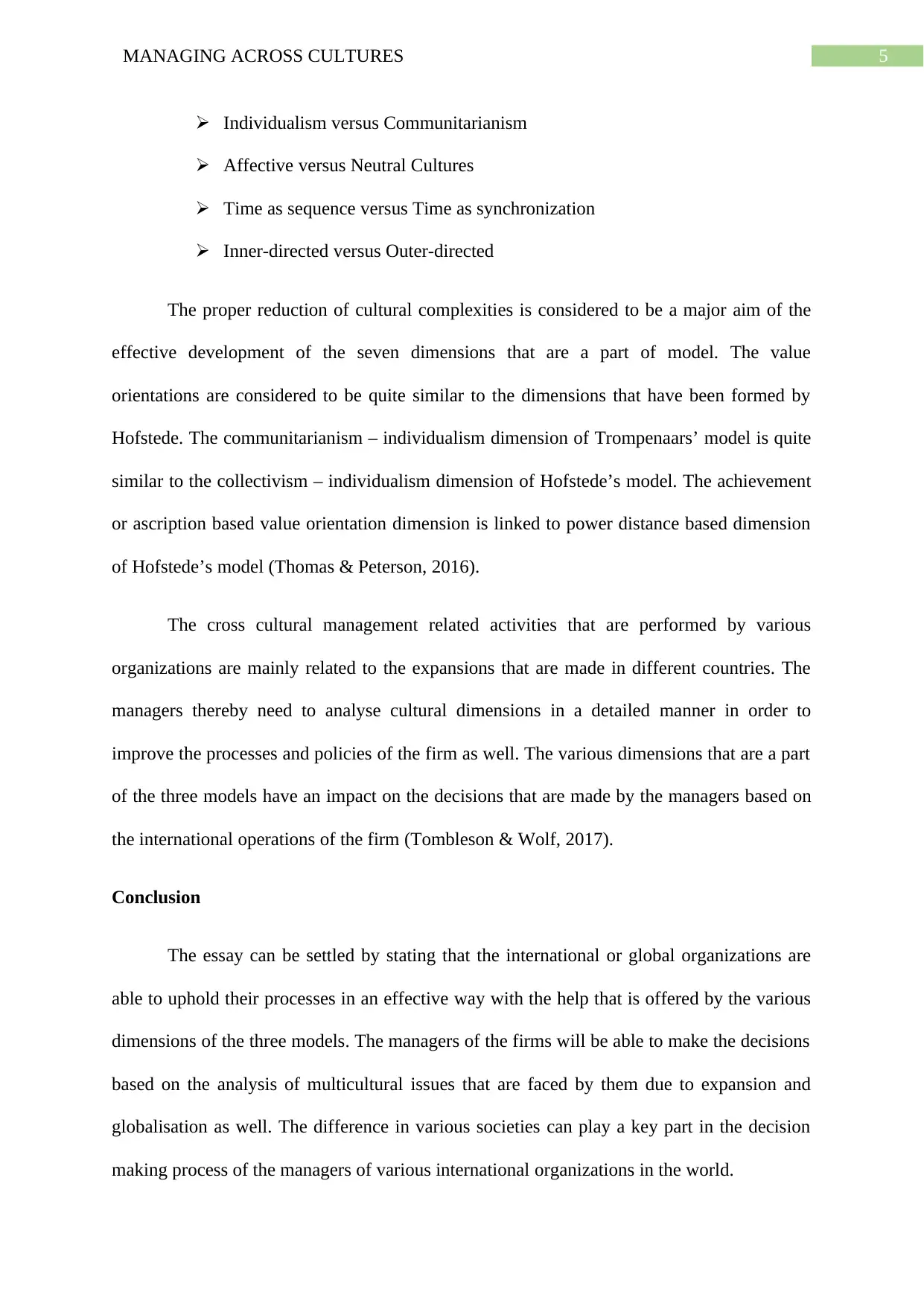
5MANAGING ACROSS CULTURES
Individualism versus Communitarianism
Affective versus Neutral Cultures
Time as sequence versus Time as synchronization
Inner-directed versus Outer-directed
The proper reduction of cultural complexities is considered to be a major aim of the
effective development of the seven dimensions that are a part of model. The value
orientations are considered to be quite similar to the dimensions that have been formed by
Hofstede. The communitarianism – individualism dimension of Trompenaars’ model is quite
similar to the collectivism – individualism dimension of Hofstede’s model. The achievement
or ascription based value orientation dimension is linked to power distance based dimension
of Hofstede’s model (Thomas & Peterson, 2016).
The cross cultural management related activities that are performed by various
organizations are mainly related to the expansions that are made in different countries. The
managers thereby need to analyse cultural dimensions in a detailed manner in order to
improve the processes and policies of the firm as well. The various dimensions that are a part
of the three models have an impact on the decisions that are made by the managers based on
the international operations of the firm (Tombleson & Wolf, 2017).
Conclusion
The essay can be settled by stating that the international or global organizations are
able to uphold their processes in an effective way with the help that is offered by the various
dimensions of the three models. The managers of the firms will be able to make the decisions
based on the analysis of multicultural issues that are faced by them due to expansion and
globalisation as well. The difference in various societies can play a key part in the decision
making process of the managers of various international organizations in the world.
Individualism versus Communitarianism
Affective versus Neutral Cultures
Time as sequence versus Time as synchronization
Inner-directed versus Outer-directed
The proper reduction of cultural complexities is considered to be a major aim of the
effective development of the seven dimensions that are a part of model. The value
orientations are considered to be quite similar to the dimensions that have been formed by
Hofstede. The communitarianism – individualism dimension of Trompenaars’ model is quite
similar to the collectivism – individualism dimension of Hofstede’s model. The achievement
or ascription based value orientation dimension is linked to power distance based dimension
of Hofstede’s model (Thomas & Peterson, 2016).
The cross cultural management related activities that are performed by various
organizations are mainly related to the expansions that are made in different countries. The
managers thereby need to analyse cultural dimensions in a detailed manner in order to
improve the processes and policies of the firm as well. The various dimensions that are a part
of the three models have an impact on the decisions that are made by the managers based on
the international operations of the firm (Tombleson & Wolf, 2017).
Conclusion
The essay can be settled by stating that the international or global organizations are
able to uphold their processes in an effective way with the help that is offered by the various
dimensions of the three models. The managers of the firms will be able to make the decisions
based on the analysis of multicultural issues that are faced by them due to expansion and
globalisation as well. The difference in various societies can play a key part in the decision
making process of the managers of various international organizations in the world.

6MANAGING ACROSS CULTURES
Paraphrase This Document
Need a fresh take? Get an instant paraphrase of this document with our AI Paraphraser

7MANAGING ACROSS CULTURES
References
Adekola, A., & Sergi, B. S. (2016). Global business management: A cross-cultural
perspective. Routledge.
Barker, G. G. (2016). Cross-cultural perspectives on intercultural communication
competence. Journal of Intercultural Communication Research, 45(1), 13-30.
Bird, A., & Mendenhall, M. E. (2016). From cross-cultural management to global leadership:
Evolution and adaptation. Journal of World Business, 51(1), 115-126.
Cross, D. E. (2017). Globalization and Media's Impact on Cross Cultural Communication:
Managing Organizational Change. In Organizational Culture and Behavior:
Concepts, Methodologies, Tools, and Applications (pp. 1078-1099). IGI Global.
Groves, K. S., Feyerherm, A., & Gu, M. (2015). Examining cultural intelligence and cross-
cultural negotiation effectiveness. Journal of Management Education, 39(2), 209-243.
Hofstede-insights.com. (2019). Compare countries - Hofstede Insights. Retrieved 16
September 2019, from https://www.hofstede-insights.com/product/compare-countries/
McSweeney, B. (2016). Hall, Hofstede, Huntington, Trompenaars, GLOBE: Common
Foundations, Common Flaws. In Transculturalism and Business in the BRIC
States (pp. 39-84). Routledge.
Merkin, R. S. (2017). Cross‐Cultural Communication Theory and Research, Overview. The
International Encyclopedia of Intercultural Communication, 1-10.
Suzuki, K., & Pheng, L. S. (2019). National Culture. In Japanese Contractors in Overseas
Markets (pp. 61-75). Springer, Singapore.
References
Adekola, A., & Sergi, B. S. (2016). Global business management: A cross-cultural
perspective. Routledge.
Barker, G. G. (2016). Cross-cultural perspectives on intercultural communication
competence. Journal of Intercultural Communication Research, 45(1), 13-30.
Bird, A., & Mendenhall, M. E. (2016). From cross-cultural management to global leadership:
Evolution and adaptation. Journal of World Business, 51(1), 115-126.
Cross, D. E. (2017). Globalization and Media's Impact on Cross Cultural Communication:
Managing Organizational Change. In Organizational Culture and Behavior:
Concepts, Methodologies, Tools, and Applications (pp. 1078-1099). IGI Global.
Groves, K. S., Feyerherm, A., & Gu, M. (2015). Examining cultural intelligence and cross-
cultural negotiation effectiveness. Journal of Management Education, 39(2), 209-243.
Hofstede-insights.com. (2019). Compare countries - Hofstede Insights. Retrieved 16
September 2019, from https://www.hofstede-insights.com/product/compare-countries/
McSweeney, B. (2016). Hall, Hofstede, Huntington, Trompenaars, GLOBE: Common
Foundations, Common Flaws. In Transculturalism and Business in the BRIC
States (pp. 39-84). Routledge.
Merkin, R. S. (2017). Cross‐Cultural Communication Theory and Research, Overview. The
International Encyclopedia of Intercultural Communication, 1-10.
Suzuki, K., & Pheng, L. S. (2019). National Culture. In Japanese Contractors in Overseas
Markets (pp. 61-75). Springer, Singapore.

8MANAGING ACROSS CULTURES
Thomas, D. C., & Peterson, M. F. (2016). Cross-cultural management: Essential concepts.
Sage Publications.
Tombleson, B., & Wolf, K. (2017). Rethinking the circuit of culture: How participatory
culture has transformed cross-cultural communication. Public Relations
Review, 43(1), 14-25.
Warren, T. L. (2017). Cross-cultural Communication: Perspectives in theory and practice.
Routledge.
Thomas, D. C., & Peterson, M. F. (2016). Cross-cultural management: Essential concepts.
Sage Publications.
Tombleson, B., & Wolf, K. (2017). Rethinking the circuit of culture: How participatory
culture has transformed cross-cultural communication. Public Relations
Review, 43(1), 14-25.
Warren, T. L. (2017). Cross-cultural Communication: Perspectives in theory and practice.
Routledge.
1 out of 9
Related Documents
Your All-in-One AI-Powered Toolkit for Academic Success.
+13062052269
info@desklib.com
Available 24*7 on WhatsApp / Email
![[object Object]](/_next/static/media/star-bottom.7253800d.svg)
Unlock your academic potential
© 2024 | Zucol Services PVT LTD | All rights reserved.




